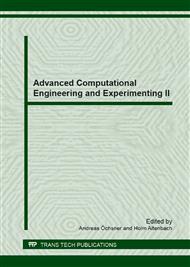p.13
p.23
p.29
p.35
p.41
p.47
p.53
p.59
p.67
A Comparison of Tensile Strength and Impact Energy of Austempered versus Step Quenched 4340 Ultra High Strength Steel
Abstract:
This study was conducted to determine if austempered 4340 steel had different mechanical properties compared to step quenched 4340 steel. Tensile strength and impact energy was determined at room temperature under identical test conditions. The specimens were cut from a bar with 25 mm diameter and austenitized at 800°C for 60 min and followed by quenching at 430°C for the high austempering temperature to achieve the upper bainite morphology and at 360°C for the lower austempering temperature to achieve the lower bainite morphology. In the case of step quenched, the specimens were first austempered at 430°C and then austempered at 360°C to achieve the mixed structure of upper bainite and lower bainite morphology. The another set of specimens for step quenching, after austenitization were quenched to below Ms (martensite start temperature), followed by heating at 400°C to achieve the mixed structure of tempered martensite and lower bainite and 500°C to achieve the mixed structure of tempered martensite and upper bainite. It is also shown that the best combination of strength and ductility can be achieved by the mixed structure of tempered martensite and lower bainite that has been suggested in this investigation.
Info:
Periodical:
Pages:
41-45
Citation:
Online since:
June 2013
Price:
Сopyright:
© 2013 Trans Tech Publications Ltd. All Rights Reserved
Share:
Citation:


